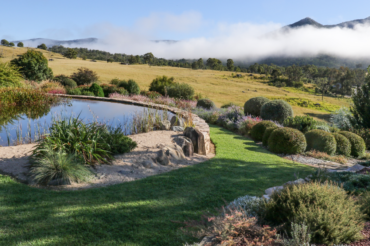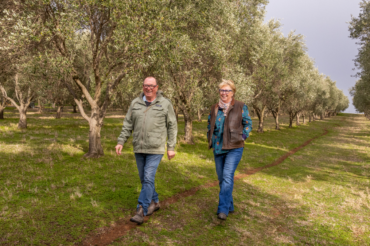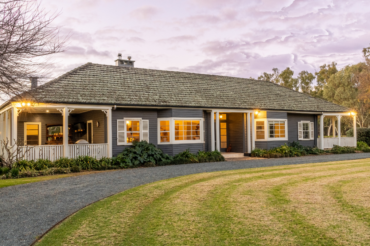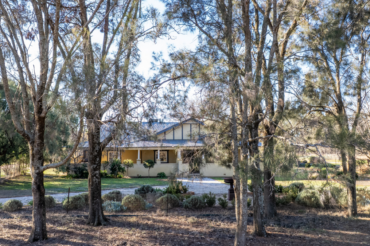
Douglas Blain’s life has been devoted to rescuing old buildings and turning them into boutique hotels.
Douglas Blain was five years of age when he took control of his life. “My favourite books were Winnie The Pooh and The Wind in the Willows so all I could do, to get to that world, was dig a huge hole in my garden,” he recalls. “I grew up believing that anything was possible with a bit of brain, and a bit of go, but I had to get out of Tasmania quick smart. Hobart was tiny then, there was no connection with the outside world, and it was very boring if you were an ambitious kid.”
Douglas wasn’t just ambitious. He was clever. He had faith in himself and “a hell of a lot of gall”. His audacious determination lead, in time, to the establishment of the business partnership that is the foundation of the highly successful Hazlitt’s Hotel Group in London.
And yet, Tasmania was not forgotten. It was to become one of the greatest loves of his life. He returns regularly to the island state with a heartfelt commitment to preserve the past. He helped to restore Brockley Estate, at Buckland, the historic 10,000-acre (4046-hectare) Merino property now owned by the Tasmanian Land Conservancy, and he reclaimed Hobart’s Corinda, the 1870s family jewel built by his great-grandfather and now reinvented as a boutique hotel (managed by his nephew Julian Roberts).

The story of Douglas Blain begins after he finished studies at The Hutchins School in Sandy Bay and began working at Hobart’s Mercury in the late 1950s. Shorthand wasn’t an easy skill to learn and there were few editorial-accuracy checks, so the young journalist crafted his subjects to sound more interesting than they were in reality. “I flattered the hell out of people and that meant that I was hitting the front page more than I had a right to,” he remembers.
He began freelance writing for mainland magazines — Wheels and Sports Car World — and then hatched an escape plan having secured his passage on an ocean liner bound for Europe. He disembarked in Italy, bought a vintage Lancia Aurelia for journeying across the areas in northern Italy where the famed Italian firms of Ferrari, Lancia and Lamborghini are based, meeting the designers, test-driving the cars and writing articles.
By the time he arrived in London, in the early 1960s, he was “completely skint”. The self-confessed car nut continued writing for magazines like Car, test-driving vehicles on trips in remote and exotic locations such as North Africa and Turkey, pioneering a new style of car journalism that described the journey, the people and the places as much as the cars themselves. Later, he took over the monthly specialist magazine on historic cars, The Automobile, and continued writing articles.
“It was an exciting time,” Douglas says, recounting memories in front of a large plate of oysters at one of his favourite hangouts, The Royal Automobile Club, in Pall Mall, London. It’s exactly the right place for a man with a madness for good cars and fine architecture through a life journey characterised by improbable opportunity and inexorable ambition.
“I loved the period buildings of Britain,” he continues, glancing upwards at a gilded ceiling in the Grand Gallery restaurant. “They were vastly more ancient than any I’d seen in Australia.”
It was the proceeds of a profitable uplift in the value of his first house in London’s Fulham that kick-started a movement to satisfy his interest in early English architecture. His passion led, inevitably, to the creation of the delightfully quirky hotel group that began with Hazlitt’s in Soho, stepped up a notch with The Gore at Kensington and The Rookery in Clerkenwell and culminated with Batty Langley’s in Spitalfields.
Spitalfields would not be the fashionable hotspot of today without the pioneering preservation work of The Spitalfields Historic Buildings Trust. Douglas was one of those recruited to assist in the campaign to save a strip of early Georgian houses built for Huguenot silk weavers escaping persecution in France in the 1700s but threatened with demolition to make way for high-rise developments as the city inched ever eastwards.

“It was tragic to see these houses wasted, falling down, being demolished,” he recalls. “Atmosphere is the easiest thing to destroy and the hardest thing to create. It’s not about money. It’s about soul.”
Batty Langley’s is nestled amid the cobbled streets and high-rises on Folgate Street. It’s close to Spitalfields Market and the spectacular Baroque Christ Church, but there’s nothing outside to indicate that this is a hotel. Guests are “buzzed-in” to a quiet world of well-kept secrets.
Next door, Dennis Severs’ House is a still-life drama, a kind-of museum created as a historic imagination of life for a family of Huguenot silk weavers. It’s a bonus for Douglas who introduced Dennis to Spitalfields and then watched him create a time capsule while still living in the house bought from the trust.
As dereliction and decay gradually became a thing of the past in Spitalfields, houses were privately acquired without need for intervention, but Douglas continued to run the charitable trust and worked to preserve a rich seam of historic buildings in other parts of Britain. Meanwhile, with business partner Peter McKay, Douglas conceived an idea to restore period buildings in central London by turning them into slightly eccentric Georgian-style hotels.
Hazlitt’s on Frith Street, a haven just off Soho Square, is one of these hotels (circa 1718) reliving history in the present. It’s like walking through a portal into a distant era. Hushed interiors hurtle you back to the 18th century with thrice-shined original mahogany furniture, damask coverlets, portraits of grandees, ruby-rich rugs and silken drapes. The essayist William Hazlitt lived and died in the house (in 1830) and his presence is felt everywhere, but especially, perhaps, in the bookcases filled with works by writers JK Rowling, Bill Bryson, Ted Hughes and Seamus Heaney.
The service is discrete, yet warm, and breakfast comes on a tray to a four-poster bed. The clientele here used to be more mature, people who wanted to recapture the nostalgia of lost times, but the townhouse hotel appeals increasingly to younger people discovering the past for the first time. Hazlitt’s came into being after Douglas overheard a party conversation in which an architect was discussing the upcoming sale of three untouched 18th-century townhouses in Soho. He decided to investigate further and, with Peter’s agreement, placed a counter bid on the properties.
The newly restored hotel was never publicised but word got around, creating its own momentum. There’s no lift at Hazlitt’s, just a wonky old staircase, charmingly crooked walls, floors that rise and dip in unexpected places, and it’s loved just the way it is.
The same can be said for Douglas and Peter’s third hotel, The Rookery, not far from St Paul’s Cathedral and the Old Bailey at Smithfield. From the Middle Ages, this was a famous cattle market outside the jurisdiction of the City Guilds, a villainous place of little law enforcement and, reputedly, the home of Charles Dickens’ immortal rascal, Fagin.
The premier suite, the Rook’s Nest, has a soaring 12-metre spire ceiling with “chim chiminey” views across the rooftops of London. The bedroom is dominated by an ornate four-poster bed with luxuriously heavy drapes and there’s a Victorian bathing machine on a raised plinth in one corner of the room. There is nothing austere or commonplace about romance here. And that, in a way, is the point.
Douglas still feels he has responsibility to help preserve the romance of the past. His inclination extends to the other end of the world where there is another project under consideration. Without giving too much away, he’s thinking about an Australian hotel in country New South Wales, in need of rescue.
“You would die for it,” he says, casting aside his plate of empty oyster shells. “The building is beside a strong flowing river which communes with the Hawkesbury. It’s an original sandstone building, 1830 or so, with stone floors and mantled fireplaces. It has belonged to one family for generations and, if it happens, it will be one of the go-to-places because it’s just so romantic.
The thought sends Douglas, now 85, spinning back to his beginnings. Back to Tasmania. Back to the feeling that he can’t wait to return. “When I came to Britain, Australia was somewhere that you hardly dared mention but, today, it’s an established tourist destination with all the aspects of a thoroughly civilised society,” he says. “I’m pretty sure Hobart — so backward and so isolated when I was growing up — is going to become a cultural capital, if it isn’t one already.”
Photography Martin Kaufmann and Supplied by Hotels









